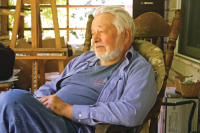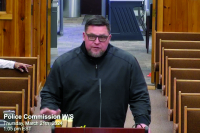EBCI census will impact Tribal Council outcomes
The Eastern Band of Cherokee Indians is trying for the first true census of its citizens in more than 20 years with an electronic-only census open to tribal members through Aug. 31.
Tribe to conduct census
For the first time in 22 years, the Eastern Band of Cherokee Indians will conduct a census of its tribal members.
Census deadline fast approaching
The census deadline is Sept. 30, and response rates are low in WNC counties, meaning that the region could miss out on millions of dollars in federal funding over the next 10 years if citizens don’t submit their responses in the next week.
COVID-19 delays 2020 U.S. Census progress
Filling out the 2020 U.S. Census form is easier than ever, yet response levels are still significantly lagging in many Western North Carolina counties.
Cherokee to conduct census
A census of people living on the Qualla Boundary will soon begin following a unanimous vote from Tribal Council to approve $273,000 for the project.
Reading between the census lines
Although population in Western North Carolina increased only by a modest amount over the past decade, home construction grew at a much higher rate, according to 2010 census data released last week.
The census counts year-round residents. But much of the growth in WNC has come from second homes — and as a result isn’t reflected when looking at population numbers alone.
Hard data on the number of second homes and the region’s summertime population can be difficult to ferret out. But the latest census shows the growth in housing units has outpaced population growth, confirming the second home dynamic that people who live here year-round witness.
ALSO: See the graphs
“You can definitely feel when summer season is coming back,” said David Francis, a Haywood County resident and the head of the county tax department. “You can just tell from the traffic on a Friday afternoon. Where I really see it is at Ingle’s.”
While long lines and empty shelves at the grocery store are a sure sign that the seasonal population has returned, the summer influx of residents is witnessed in every facet of society, from more trash at the landfill to more people at the emergency room.
Seasonal residents translate into a 15 to 20 percent increase in trash at the Haywood County landfill, Francis said.
The emergency room at MedWest Harris in Sylva sees a seasonal spike in patient volume of 10 to 15 percent during the summer and fall compared to winter, according to numbers provided by Lucretia Stargill, a MedWest spokesperson. Ambulance calls likewise increase in the summer, according to Jim Pressley, the EMS director for Haywood County.
In Maggie Valley, a town full of vacation homes, users at the town library go way up in summer, according to Town Manager Tim Barth. So does the need for police officers. It means the department is slightly overstaffed in the off-season.
“Right now there may not be a lot of people in the Valley. But you can’t just hire police officers for two or three months. That doesn’t work very well,” Barth said.
Running a community with such seasonal population swings isn’t easy. It must have adequate infrastructure to serve the larger population. In Maggie Valley, the sewer treatment plant has a much larger capacity than its year-round population of 1,100 would typically dictate.
“We have to assume that everybody will be in Maggie Valley all at one time, and that is what we have to plan for,” Barth said.
While thousands of seasonal Maggie residents make a wintertime exodus back to Florida, they continue paying a sewer bill of $15 a month while they’re gone, even if their water is completely shut off, Barth said. The minimum monthly bill allows the sewer treatment plant to be keep operating during those months and be in working order when the masses return.
The building surge of the past decade forced counties to grapple with all kinds of infrastructure issues. Ken Brown, Chairman of the Tuckasegee Community Alliance in Jackson County, pointed to the dispute between the Glenville Fire Department and second-home owners on an island in the middle of the lake. The second-home owners wanted the volunteer fire department to provide fire service, even if it meant taking a fire truck across the lake on a barge.
“I thought it was offensive actually they could buy an island then demand the county provide them fire service,” Brown said.
Second-home growth also takes its toll on natural resources, from construction-site erosion muddying the streams to view-obscuring smog from vehicles.
Public lands, which are home to the last remaining Appalachian ecosystems, are also feeling the squeeze. As development spreads across the landscape, it’s pushing up against the Pisgah and Nantahala national forests and encroaching on wildlife habitat. The National Forest Service ranked the Pisgah and Nantahala among the top five forests threatened by periphery development in a 2009 report called “National Forests on the Edge.”
Meanwhile, more people are recreating in the national forests, testing the carrying capacity of the public lands that make WNC such a desirable place to live, according to Brent Martin, the Southern Appalachian director of The Wilderness Society in Sylva.
How many second homes?
Mark Clasby has spent much of the past decade trying to quantify the second-home market in Haywood County.
“It is a very important part of our economy,” said Clasby, the county economic development director.
The potential buying power of Haywood County’s population can make or break whether a new business comes here. Clasby has been trying to pedal a mega commercial site once slated for a Home Depot that was cancelled after the recession took hold. Finding a retailer of that magnitude to fill the void has been tough.
“What they tend to look at when they pick a location is they want to know what the population is,” Clasby said. “We try to make an argument that we have more people here than what census numbers show. What I have to use is unscientific.”
One figure Clasby points to is the number of property tax bills mailed out of the county. In Haywood County, one-third of tax bills are mailed out of the county, indicating the property owner has a primary residence somewhere else. In Macon County — an even bigger second-home market — 54 percent of tax bills are mailed out of the county.
Five years ago, the Downtown Waynesville Association commissioned a study on where shoppers come from. Over 70 businesses throughout town recorded the zip codes of those making purchases, including those who were second-home owners. Second-home owners accounted for 12 percent of shoppers at participating shops the last week in July.
But second-home residents aren’t just here in the summer anymore.
“I think our seasonal folks increase starting in the spring and go into the fall and some all the way through the holidays,” said Linda Schlott, the director of the Main Street Program in Franklin.
And that’s good news for business owners.
“We can see an increase in people on the streets and merchants see an influx of customers when those seasonal visitors are here,” Schlott said.
Some second-home owners actually live here more months of the year than they do in their so-called primary residence. But the absence of income tax in Florida makes it advantageous to claim that state as their permanent residence.
Real numbers at last
The census offers a glimpse into just how many homes in our midst may be second homes or vacation rentals. To census workers, any house not occupied by a full-time resident was designated “vacant.”
In Haywood, 27 percent of homes were deemed “vacant.” In Swain, it was 35 percent. In Jackson, it was 37 percent. And in Macon it was a whopping 42 percent (see chart).
The numbers are even more staggering in quintessential vacation and second-home markets. In the town of Maggie Valley, two-thirds of the housing units were “vacant.” In the town of Highlands, “vacant” homes account for 78 percent of the housing stock.
A small portion of the housing units deemed “vacant” by the census are truly that. There’s a baseline of legitimately vacant houses, such as rentals that are between renters or empty houses where the owner has died.
Statewide, the average vacancy rate is only 13 percent. That average includes places like the beach and the mountains with a preponderance of vacation condos and second homes. For a typical city where these aren’t a factor, like Greensboro or Durham, the vacancy rate is 9 to 10 percent.
In Jackson County, student housing contributes to the high percentage of “vacant” housing units. Several apartment buildings have gone up over the past decade aimed at students attending Western Carolina University. Perhaps too many apartments, said Mark Jamison, a resident of nearby Webster. The university predicted exponential growth of students that hasn’t materialized completely.
“You have an inventory created on suppositions that probably aren’t going to come true,” Jamison said.
Another factor in the number of vacant homes on the census roster is speculative building. During the boom years, the line of prospective second-home buyers seemed endless, prompting developers to build spec houses rather than merely sell off lots. Some contractors would even buy lots to build spec homes of their own.
But when the stream of buyers dried up, those homes were left standing, explained Danny Wingate, the vice president of Haywood Builders.
Sitting idle
The 2010 Census reveled a high number of second homes not occupied by year-round residents. Here’s the percentage of “vacant” homes by county.
Haywood 27 percent
Jackson 37 percent
Macon 42 percent
Swain 35 percent
Total housing units by county:
Haywood 34,954
Jackson 25,948
Macon 25,245
Swain 8,723
Urban areas to steal more seats in Raleigh, leaving the mountains with less
Urban areas grew at a torrid pace over the past decade — so get ready, legislators in the mountains and on the coast, because your already large districts are about to expand.
Why? Because, as Christopher Cooper, a political science professor at Western Carolina University explained, even though there are very few rules about exactly how voting lines are drawn, there are two guiding principles.
First, lines cannot be drawn with race as the predominant factor; and secondly, there should be approximately the same number of people in each district.
Since urban areas grew faster than rural ones, that must be represented when lines are redrawn, said Cooper, who oversees a university-sponsored blog focused on North Carolina politics.
The state, as a whole, grew more than 18 percent. Much of that population surge occurred in Mecklenburg and Wake counties, and in those counties abutting them. Northwest North Carolina also experienced strong growth. These places are entitled to more representation in Raleigh beginning in 2012, while rural counties in WNC will get less.
“Since we hold constant the number of representatives in Raleigh, then those additional seats (for urban areas) have to come from somewhere,” Cooper said.
Voting districts in the mountains will expand to take in larger geographic areas, freeing up legislative seats for faster-growing urban areas.
Rep. Ray Rapp, D-Mars Hill, serves on the House Redistricting Committee. He said it’s too early to know exactly how mountain and coastal districts will expand, but the shifts must take place. Western North Carolina is bounded by three states, so expansions must flow eastward: Tennessee, Georgia and South Carolina are unlikely to look favorably on a land and population grab.
That, Rapp said, will setup an eastward district-redrawing cascade of sorts. The veteran legislator emphasized that he doesn’t expect mountain dwellers to experience nearly the redistricting changes eastern North Carolinians can anticipate. Some counties on and near the coast saw population declines.
WCU Professor Cooper said residents in the state’s westernmost counties aren’t likely to look on changes favorably.
“Folks in the west have long felt that their voices are not heard in Raleigh and any change in the number of representatives we receive will only further erode trust in state government,” he said. “This is not only a North Carolina phenomenon — the farther you get from the capital, the lower the information about state politics and the less trust people have in their state government.”
Jim Davis, R-Franklin, a newly elected member of the N.C. Senate, isn’t particularly worried, though his analysis of the 2010 census data indicates the 50th District he represents will grow larger, despite already spanning parts of eight counties.
“It will have to expand quite a bit,” Davis said.
The Franklin orthodontist said he doesn’t view a larger district as a hindrance. Additionally, Davis described the state’s eastern legislative delegation as “kindred spirits” to those who represent the west. Much of North Carolina is rural, Davis said, and that creates commonalities transcending simple geography.
U.S. congressional districts, too, must reflect the population shift in North Carolina. But, in that those districts are so large already, changes are unlikely to seem as profound. Andrew Whalen, senior advisor for U.S. Rep. Heath Shuler, D-Waynesville, said prior to the census-data release he expected the congressman might pick up a few counties to the east.
Redistricting, required by federal law every 10 years when updated census data is released, comes as Republicans have grabbed control of the General Assembly for the first time in more than a century. Previous redistricting in North Carolina proved acrimonious, with Republicans accusing then-in-power Democrats of drawing the lines to their political advantage, or gerrymandering districts.
District maps were redrawn three times in as many years from 2001 to 2003 because of Republican-filed lawsuits; primary elections were delayed twice as a result, in 2002 and 2004.
Sen. Bob Rucho, R-Mecklenburg, the Senate Redistricting Committee’s chairman, says the GOP will draw districts correctly and fairly. Redistricting meetings get under way next week.
Time to redraw
The General Assembly is required to redraw voting districts for North Carolina after every census. Once adopted, a valid redistricting plan cannot be changed during that decade.
The 170 legislative districts for the N.C. Senate and House, and the 13 U.S. congressional districts, must be exactly or nearly equal in population — ensuring equal representation under the principle of one person, one vote. As the population grows, voting districts likewise must include more people.
Each representative in the N.C. House will represent about 79,500 people; state Senators about 191,000 people. Each congressional district must have 733,500 people. The redrawn districts take effect starting in 2012.
Macon loses bragging rights for fastest growing county
Macon County isn’t exactly asking for a recount, but officials here do want to know why the county’s 2010 census numbers fell well short of what they expected — call it more of a pointed request that federal census workers review their data.
After all, Macon might well be the Western North Carolina county that put the most concentrated effort into accurately counting every single resident. County Manager Jack Horton and Planner Derek Roland held census information meetings, such as speaking in front of the League of Women Voters prior to the census, on how important getting an accurate count would prove in the next decade when it comes to Macon County’s financial wellbeing.
The two men explained the U.S. Census determines the amount of money the community might get to support hospitals, job-training centers, schools and more. It directly affects the county’s cut of sale tax revenue. For the town of Franklin, population dictates how much it gets from the state for building sidewalks.
And, they emphasized at that luncheon, the data would help determine elected representation at both the state and federal level. To that end, in an effort to ensure an accurate number, Macon County formed a Complete Count Committee made up of local officials and residents.
So what happened?
Horton said he was taken aback last week when the U.S. government released the numbers. Here’s what they showed: Macon County, once touted as one of North Carolina’s fastest-growing counties, simply isn’t that anymore, if the 2010 U.S. census numbers are correct. Macon County lagged behind growth rates posted by neighboring Jackson and Clay counties (noting that when you are as small as Clay County, which went from 8,775 people to 10,587, the percentages are heightened by significantly smaller numbers of people moving in than would be true for larger communities).
Here’s the hard numbers: Macon County grew over the last decade by about 14 percent, with 33,922 people living there. Jackson County had an almost 22 percent growth during that same period, Clay County nearly 21 percent. That increase on either side of the Macon County’s borders frankly strikes Horton as strange — what happened to the growth rate in Macon County, which just a decade ago was chugging along at a 27-percent increase?
Some of that growth-rate decline might just be attributable to the “hidden” residents of Macon County, said longtime county manager and Franklin native Sam Greenwood, who after retiring from county government promptly went back into public service as the town’s manager.
Maybe even more residents are hiding, or not exactly hiding, but more and more Macon County residents perhaps technically live out of state yet are spending ample time in Macon County. Enough time, certainly, to burden a public-service system that receives state and federal funding for far fewer souls, as recorded by U.S. Census counters.
Greenwood, tired of anecdotal evidence and strong suspicions on this very subject, about four years ago encouraged a Western Carolina University student interning with Macon County to review the data. The student, using tax records, electrical hookups and such, found that local government was really providing services to just more than 59,000 residents. About 35,500 of those were fulltime (a higher number, you’ll note, than the just released census number, even discarding any part-time and seasonal residency, as the federal government does).
Brian McClellan, chairman of the Macon County Board of Commissioners, said the census showed his county clearly needs to diversify its economic base. Macon County was too reliant, he said, on the home building and real estate sector. Additionally, with discretionary income taking a hit in a sour economic climate, the jobs spurred by tourism that might have attracted newcomers also decreased.
“Jackson County has a university with all the attendant jobs that entails,” said McClellan, a financial advisor in Highlands for Edward Jones. “Even in a difficult economic period, it’s just not hit as hard as other parts of the economy. That university is certainly a very good thing for them, and they have a bigger hospital — people don’t quit getting sick in a poor economy.”
Jackson County increasingly attracting young professionals
For upwardly mobile professionals who are looking for an outdoor lifestyle, scenic mountain beauty and the company of like-minded individuals, Jackson County has proven the perfect fit.
Just-released 2010 census data shows Jackson County emerging over the last decade as the fastest-growing county among the state’s 18 westernmost counties. The county grew from 33,273 people in 2000 to 40,271 last year, an increase of 21 percent.
It doesn’t take a demographer’s skills to pinpoint where that growth came from, not with the bottom falling out of Western North Carolina’s construction and real-estate sector: the anchor of the county’s economic base has been Western Carolina University. Supporting roles are played by numerous governmental institutions that serve the whole region but have their headquarters in Jackson — such as Southwestern Community College, the N.C. Center for Advancement of Teaching, Southwestern Development Commission, the N.C. Department of Transportation and Smoky Mountain Mental Health.
Who fueled the growth?
Teresa Killian Tate, 35, who works in WCU’s office of public relations, is one of the faces of this growing-ever-more-professional Jackson County. She was a police-beat reporter for the Spartanburg Herald Journal in South Carolina when the bug to move to WNC hit.
The Asheville native started coming to the far western counties to take advantage of the Nantahala River. Then she took up mountain biking and was soon riding the trails in Tsali Recreation Area.
“I started thinking, ‘Gosh, some people actually live here — how does that happen?’” Tate said.
Then she heard WCU Chancellor John Bardo’s message that he wanted the children of the mountains to have jobs in the mountains and be able to stay and work in this region. “I was so moved,” Tate said. “It inspired me to want to be a part of this community.”
Others, like Tate, were equally intentional in their selection of Jackson County. Or, to be more accurate, in their selection of WNC — more often than not, Jackson County simply has the jobs available that this career-minded, educated population seems to be searching for. Once here, however, the burgeoning downtown scene in Sylva has kept them entertained, and Asheville is just a hop, skip and a jump away for those needing a taste of big-city life.
Thirty-year-old Taylor Bennett, who lives in Cullowhee and owns a building company, Riverwood Custom Creation, is a 2003 WCU graduate who discovered he wanted to make his home in Jackson County.
The Greensboro native, who received a degree that had a concentration in outdoor leadership, helped a friend start a Dillsboro river company. He shifted to building, and eventually started his own company, which has found a comfortable Jackson County niche in areas such as building “green” and in energy retrofitting. Times have gotten tougher, but for now, Bennett is holding his own in the rough economic climate.
“This is somewhere I’d love to stay,” said Bennett, whose wife also attended WCU.
Bennett touted the growing contingent of “young professionals,” and an increasingly vibrant downtown scene in Sylva, as reasons he loves calling Jackson County home.
These days, Sylva boasts plenty of bars, but also trendy restaurants, and perks such as a bakery, brewery and farmers market.
“Our goal was to get back to the mountains, though not necessarily Jackson County,” said Rose Bauguess, 35, on her move here.
Bauguess is from Clay County, her husband, Greg, from Wilkes County. The couple has two children. She telecommutes for a Raleigh environmental consulting firm; he works at WCU as director of development.
Rose Bauguess has been impressed by the development of Sylva from what she remembers as a child — more “happening,” perhaps, than her hometown of Hayesville, but not exactly what most people would consider hip — to today’s modish downtown.
Another newcomer who helped propel Jackson to the region’s fastest growing county over the past decade is Elizabeth Gillespie, 50, who picked WNC as the place she wanted to live after spending time here seasonally, then ferreted out a job and new career to help enable that dream. Gillespie is highly educated. She brings extensive previous professional experience to the table, including nine years as the vice president and production manager for Granny Gear Productions, a sports marketing and events company. She proved the perfect fit, in turn, as a public communication specialist for the Center for the Advancement of Teaching, where kindergarten through high-school teachers from across the state take advantage of cross-disciplinary classes.
“I love being in a town that is this closely connected to a university,” said Gillespie.
A study in contrasts
Neighboring Macon County, which relied almost exclusively on home building and real estate to underpin its economy, by comparison saw growth slow drastically. Macon County grew from 29,964 people in 2000 to 33,922 last year, an increase of just more than 13 percent — half the growth rate posted in 2000 for the previous decade, when Jackson County’s neighbor was booming at a 26-percent rate.
“We had a lot of our eggs in one basket, and unfortunately, that was a basket that got dropped,” said Brian McClellan, a financial advisor in Highlands with a doctorate degree from Clemson University who serves as chairman of the Macon County Board of Commissioners.
Bigger is not always better, but when it comes to census data, larger matters: federal and state funding is often directly tied to the population count.
“I was pleasantly surprised at the growth in the county and the fact that our population has now moved beyond 40,000,” said interim County Manager Chuck Wooten, who also lives in Jackson County because of a job with WCU. Wooten in January retired after 30 years as the top finance officer there.
“The university may very well be one of the factors for growth since the Cullowhee township is now our largest township,” Wooten said. “I’m going to ask (Planner) Gerald Green to dig into the census numbers so we can understand where the growth in the county took place.”
What could the census data mean for Jackson County? Wooten said he hopes to soon understand the unexpected growth and ensuing effects better, but for now: “Obviously, I would anticipate that with the additional growth would come some additional revenues like increased sales tax, etc.,” he said. “But, it could also generate more demands for services so net gain may not be significant.”
Mark Jamison, a resident of Webster, fears Jackson County might lose its identity because of the growth.
“If communities don’t define who they want to be, they let other people and other forces define them and try to catch that wave and ride it wherever it takes them,” Jamison said. “We don’t want to turn our county into nothing but gated developments or a university town.”
More than population stats hinge on accurate census
The census has been part of government since Roman times and it has the baggage to prove it. As the U.S. Census Bureau kicks off its 2010 effort, the federal agency is enlisting the help of local organizations to help communicate the message that an accurate count is crucial to the federal government and does not involve the sacrifice of personal privacy.
"It's extremely important that community organizations and local governments partner with the census so we can spread the word about how it works and what it does," Andrea Robel, community outreach coordinator for the Bureau's Charlotte office. "If a county has as few as 100 people uncounted, that's leaving millions of dollars on the table over 10 years."
Derek Roland, Macon County's planning director, has coordinated the complete count committee, which boasts participation from over 20 organizations around the county including immigrant populations. Roland said the county manager and its commissioners were adamant about supporting the census effort from the start. "Number one, it's about money," Roland said. "The census determines up to $400 billion in federal funds that come to counties each year and the more accurate our count is the more we benefit."
The U.S. Census occurs every 10 years as required by the U.S. Constitution and its aim is to count every resident, including non-citizens, in the United States. The 2010 census will be used to distribute more than $400 billion of federal money to local institutions. B.J. Wellborn, media team leader for a five-state U.S. Census Bureau office based in Charlotte, is in charge of coordinating the public relations effort in an area that includes rural Western North Carolina. The Census Bureau launches a 2010 Census Road Tour this month, which will visit Franklin in March. The Road Tour will communicate the importance of the census directly to the public.
"It's really an attempt to get around the state and visit neighborhoods, particularly neighborhoods in which we may have had a hard time getting accurate numbers in the past," Wellborn said.
During the road tour, an interactive bus featuring exhibits that show the history and significance of the census as a part of American democracy, will visit communities across the country. The U.S. Census Bureau has also undertaken a paid ad campaign that will begin airing in January. For most residents the U.S. Census consists of a 10-question form that comes in the mail. But in rural areas, where people often only have a post office box or an off-site mailbox, the response to mailed surveys can be difficult to guarantee. Wellborn said the last U.S. Census boasted the best numbers ever and she expects even better accuracy this year. Still, she acknowledged the importance of local partnerships with local governments in Western North Carolina.
To that purpose Andrea Robel, the Bureau's outreach coordinator, has gotten the help of county government to create "complete count committees" capable of leading a local, grassroots information campaign. Complete count committees have been established in Swain, Jackson and Macon counties. Haywood County elected not to form a local county committee citing budget restrictions. The job of the committees is basically to reach out to their constituent groups and urge people to mail back the census questionnaire in a timely fashion.
The census does not record tax or social security information and the laws that govern the census prohibit any proprietary information from being released. Still, the public perception that the government uses the census to get in people's business is hard to shake. Census questionnaires will be mailed in March. In April, the hard work of counting people who haven't responded begins.
That's where the local groups can really help the effort, according to Robel. The Asheville census office, which serves 11 counties in North Carolina and Tennessee, expects to hire between 900 and 1,000 local people to go door to door to addresses that have not responded to the survey. The canvass workers will be hired in their home counties and must pass a basic test and fill out an online application to get hired. Support from the local count committees will help residents understand the importance of responding to the questionnaire and make the census a success across the board. Historically undocumented immigrants and rural people without mail service are least likely to respond.
Those interested in census jobs can find application information at www.2010censusjobs.gov or by calling 866.861.2010. The information is also available via the Employment Security Commission or JobsNOW.nc.gov.









